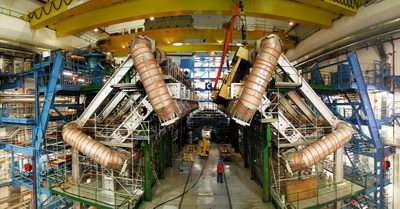Physicists Step Closer to Understanding Origin of the Universe

The world’s largest particle detector is nearing completion following the construction of its ‘endcap’ at the University of Liverpool.
Its assembly of advanced apparatus, at the University’s Semiconductor Detector Centre, has been a joint effort by physicists, engineers and technicians from the Universities of Liverpool, Glasgow, Lancaster, Manchester and Sheffield as well as Daresbury and Rutherford Laboratories.
The endcap is part of a semiconductor tracker (SCT) based at the heart of ATLAS - a giant particle detector the size of a five-storey building. The SCT will become part of the world’s largest particle accelerator – the Large Hadron Collider (LHC), based at CERN, the European Centre for Particle Physics Research, in Switzerland.
The LHC is being constructed 100 metres underground in a 16-mile long circular tunnel, running under the Franco-Swiss border. Inside the tunnel two particle beams will be accelerated to extremely high energies, and will crash into each other forty million times a second, creating a snapshot of conditions that existed billionths of a second after the ‘Big Bang’. ATLAS, the culmination of 15 years’ work by over 150 European institutions, aims to find the Higgs particle that holds the key to understanding the origin of mass.
Dr Neil Jackson, from the University’s Department of Physics, explains: “Using the LHC we are aiming to discover the Higgs particle and hoping to find evidence for so-called Super-Symmetric particles, which we believe could offer an explanation for the ‘dark matter’ in the universe. At present the normal matter that we can see in the universe accounts for only 5% of its mass. The origin of the missing mass is unknown, but Super-Symmetric particles may account for some of it. If we discover these particles then we are on our way to explaining why the universe is made the way it is.
“At Liverpool we have tested 988 detector modules and assembled them into one of two SCT endcaps. The modules will detect the reactions produced as the accelerator collides billions of protons in the centre of ATLAS. The particles produced in these collisions are recorded as they pass through the endcaps. The collisions will be strong enough to recreate particles and reactions that were present fractions of a second after the Big Bang.”
The Big Bang theory is the dominant scientific theory about the origin of the universe. It suggests that the universe was created sometime between 10 billion and 20 billion years ago from a cosmic explosion that hurled matter in all directions.
The conditions that will be reproduced at LHC will correspond to approximately 1/10,000,000,000 of a second after the ‘Big Bang’ when the temperature was 1,000,000,000,000,000 degrees. Large detectors will electronically register the movement and position of charged particles allowing physicists to analyse the reactions that created
them.
The endcap will begin its journey to Switzerland later this month. Dr Jackson added: “We have to be extremely careful that the endcap we have constructed does not become damaged on its journey to Switzerland. We have just completed a trial run of the journey, using a dummy load to represent the endcap. Accelerometers and position-sensitive detectors were positioned on the transport frame to monitor the machine and we tested driving conditions with emergency stops, sleeping policemen, gradients and motorway driving. The results of the test were very encouraging.”
Source: University of Liverpool















